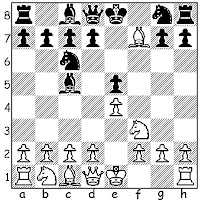
obviously - grobnic
GameKnot.com, 2004
1.e4 e5 2.Nf3 Nc6 3.Bc4 Bc5 4.Bxf7+
4...Kxf7 5.Nxe5+ Nxe5 6.Qh5+ g6
This can lead to the infamous Blackburne Defense (7...d6), or the much-less-known but much-more-dangerous Whistler's Defense (7...Qe7).
7.Qxe5 Qe7 8.Qxh8
The Database is notoriously lean when it comes to either early Jerome Gambits, or over-the-board games. Coverage of Whistler's Defense is a good example.
There are 3 early correspondence games by Alonzo Wheeler Jerome (1876, 1879) where he scored 0-2-1.
Then, over 100 years later, there are then a handful of online games at FICS: 1 in 1999 (0-1); 1 in 2001 (1-0); 3 in 2003 (1-1-1); and then 10 in 2004 (4-5-1) - 7 of which involved obviously.
So, White's 8th move in the current game (capturing the Rook) probably deserves the same annotation it garnered in The American Chess Journal, June 15, 1876, when it showed up Jerome - Norton, correspondence, 1876 -
Played experimentally; and analysis will probably show the capture to be unsound.Analysis has since shown the capture of the Rook to be unsound - but, then again, analysis, even back in the 1870s, showed the Jerome Gambit itself to be unsound...
We must remember, however, that "all is new that has been forgotten", and that both players in the current game probably had little information on either the Whistler or the Jerome to guide them. That said, obviously obviously had some knowledge of the opening, as he scored 4-0-1 with the Black pieces, and 2-0 with the White pieces.
For that matter, The Database contains 59 games with the Whistler Defense, and White scores 57% - an indication that things are complicated enough that the first player will have his chances, at least in club play.
8...Qxe4+
This is the way to show that White's King is in more danger than Black's.
Bill Wall, who seems to be able to get away with just about anything in the Jerome Gambit, once experienced 8...Qf6 9.Qxh7+ Kf8 10.O-O Black resigned, Wall,B - Sepoli, Chess.com, 2010.
9.Kd1
This move is about as strong as 9.Kf1, e.g. 9...Nf6 10.d3 (10.Nc3 Qxc2 11.h4 b6 12.Qd8 Ba6+ White resigned, grobnic - obviously, GameKnot.com, 2004) 10...Qd4 (10...Qf5 11.f3 Bf8 12.Nc3 d5 13.h4 Qd7 14.h5 Bg7 15.hxg6+ Kxg6 16.Rh6+ Bxh6 17.Bxh6 b6 18.Ne2 Qf7 19.Qf8 Qxf8 20.Bxf8 drawn Jerome,A - Norton,D, correspondence, 1876) 11.Be3 Qxb2 12.Bxc5 Qxa1?! (12...d6 13.Ke2 Qxc2+ 14.Nd2 Bg4+ White resigned, flatchio - obviously, GameKnot.com, 2004) 13.Qf8+ Ke6 14.Qe7+ Kf5 15.Ke2 Qe5+ 16.Qxe5+ Kxe5 17.Re1 d6 18.Kf3+ Kf5 19.Bd4 Kg5 20.h4+ Kf5 21.Re7 Nd5 22.g4 checkmate, Wall,B - Neilson,C, Melbourne, FL 2017.
9...Qg4+
This move is good, but perhaps not quite as strong as 9...Qxg2, e.g. 10.Re1 (10.Qxh7+ Kf8 11.Re1 d5 12.d4 Bg4+ 13.Kd2 Qxf2+ 14.Re2 Qxe2+ 15.Kc3 Qc4+ 16.Kd2 Qxd4+ 17.Ke1 Qd1 checkmate, blackburne - perrypawnpusher, Jerome Gambit thematic, ChessWorld.net, 2008) 10...Qf3+ (going for a repetition in a winning position) 11.Re2 Qh1+ 12.Re1 Qf3+ 13.Re2 Qh1+ 14.Re1 Qf3+ drawn, Wall,B - Mathieubuntu, 40 0, FICS, 2011.
Black risked most of his advantage with the reasonable precaution 9...Nf6, although he was still able to outplay his opponent: 10.f3 Qh4 11.Nc3 b5 12.Qd8 Qg5 13.Ne4 Nxe4 14.Qxg5 Nxg5 15.d4 Be7 16.d5 h5 17.h4 Nh7 18.Bf4 d6 19.Ke2 Nf6 20.Rhd1 Bb7 21.Bg5 Nxd5 22.Bxe7 Nxe7 23.g4 hxg4 24.fxg4 Rh8 25.Rf1+ Ke8 26.h5 gxh5 27.g5 Rg8 28.Rg1 Bc8 29.Kd2 Bg4 30.Rg3 Rxg5 31.Re1 Kd7 32.Rh1 a5 33.Re1 h4 34.Rge3 Nd5 35.Re4 h3 36.R4e3 Nxe3 White resigned, vallabhan - obviously, GameKnot.com, 2004
10.Ke1
White improves on the historical 10.f3 Qxg2 11.Qxh7+ Kf8 12.Re1 d5 13.Qh4 Qxf3+ 14.Re2 Bg4 15.Nc3 Bf2 White resigned, Jerome,A - Whistler,G, correspondence, 1876.
10...Qxg2 11.Qxh7+ Kf8 12.Rf1 Qe4+
Again, good, but not best (12...d5). It is still hard to see how White will survive, but he does have a material advantage...
13.Kd1 d5
Chess can be incredibly cruel.
White's defense here has in good part consisted of shuttling his King back and forth. Black now plays the move recommended in the last note - and it turns over the advantage to his opponent.
It appears he needed to play 13...Qf3+ first. What difference does the check make? White shows with his next move.
14.f3
In what appears to be a mockery of common sense, Stockfish 8 now claims that White has a clear advantage, giving 14...Qf4 15.Nc3 c6 16.Ne2 Qf6 17.d3 Bf5 18.Ng3 Re8 19.Nxf5 Qxf5 20.Bd2 Bd4 21.Kc1 Re7 22.Qh4 c5 23.a4 Re2 24.Kd1 Rg2 25.Qd8+ Kg7 26.Kc1 Bxb2+ 27.Kxb2 Rxd2 28.Qc7+ Kh8 29.Qxc5 Qxd3 30.Rf2.
14...Bg4
It is difficult to explain this move. It is tempting to suggest a mouse slip, but the time control for this game was 5 days per move.
15.fxg4+ Nf6 Black resigned
After 16.Rxf6+ Ke8 17.Nc3!? White's pieces will be able to protect his King from too many Queen checks, while Black's King will be open to great dangers.














































